Somewhere, marketing and engineering professionals are making a checklist of the features that a personal-defense handgun should have and must have to be competitive. The result is some of the most practical, useful, and reliable handguns we have seen. Some miss the boat in one regard or the other. Others are almost ideal for personal defense. The modern polymer-frame striker-fired pistol is the most popular defensive handgun by a considerable margin, with the reliability and combat efficiency of the Glock being the yardstick by which other personal-defense handguns are judged. It’s okay to want something different, but if you are betting your life on the piece, it should be a useful handgun. To sell in this market, a comparable pistol should cost less than the Glock. If there are shortcuts taken, we need to know about them. If the pistol costs more than the Glock, then we need to see features superior to the Glock’s.
In this report we test four pistols. Three are new introductions, and the fourth is one that we somehow have not yet tested until now. The Arex Rex Delta 9mm Luger, $425, and Stoeger STR-9, $350, are similar in operation and size to the Glock 17 and Glock 19 9mm handguns. The SIG P365 Nitron Micro-Compact 365-9-BXR3 9mm Luger, $465, is a polymer-framed 9mm similar in size to the Glock 43, but with higher magazine capacity as a result of its slightly staggered magazine. The Ruger Security-9 Model 3818, $309, is the only hammer-fired gun tested and the only pistol with a manual safety, and in the latter regard, it is a rarity in the market. We wanted to see how the polymer-frame compacts shot and handled head to head (SIG vs. Ruger), as well as the service-size 9mms (Stoeger and Arex). A more complicated comparison was between sizes. A lot of consumers have trouble deciding on how big a gun they want or need, so we tried to see how the different sizes performed. The Stoeger STR-9 (overall length 7.2 inches, height 5.4 inches, barrel length 4.17 inches) and the Arex Delta (OAL 6.9 inches, height 4.8 inches, 4-inch barrel) are service-size handguns, and the Ruger Security Nine (OAL 6.52 inches, height 4.35 inches, barrel length 3.42 inches) and SIG P365 (OAL 5.8 inches, height 4.4 inches, barrel length 3.1 inches) are concealed-carry handguns with 10-round magazines.
In this test, there were some remarkable things going on. Despite firing 1,600 cartridges during the evaluation, there were no failures to feed, chamber, fire, or eject related to the handguns. There were ammunition-related short cycles and shooter errors. There were handling differences we did not like, and a couple of failures of a pistol to lock open on the last shot. Only one pistol invited shooter errors, which speaks highly of the design and ergonomics of the handguns. All these dogs will run.
Ammunition Details
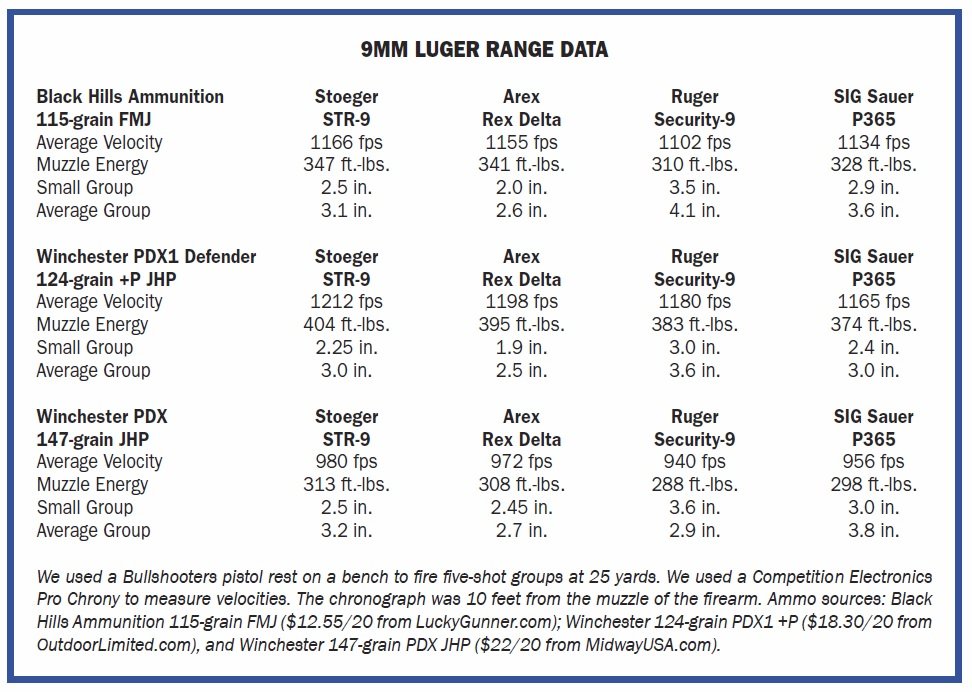
During the test period, we fired ammunition in combat shooting and standard accuracy testing. We fired three five-shot groups with each load to test accuracy. The initial work included the Jesse James brand 124-grain jacketed hollowpoints ($19/20 rounds from AmmoInc.com), Black Hills Ammunition 115-grain full-metal-jacket bullets ($12.55/20 from LuckyGunner.com), Winchester 115-grain FMJs ($20/100 rounds from Academy.com), Black Hills Ammunition 115-grain EXP jacketed hollowpoints ($15/20 from LuckyGunner.com), Winchester 124-grain PDX +P ($18.30/20 from OutdoorLimited.com), and the Winchester 147-grain PDX ($22/20 from MidwayUSA.com). We felt that this breadth of coverage would ensure the pistols were reliable with 115-, 124-, and 147-grain loads as well as +P loads. We only used five of the six loads in all testing, however, for reasons that follow. The FMJ loads fired during the range testing, 200 rounds in each pistol, were 100 of the Black Hills FMJs and 100 of the Winchester ball ammo. We also fired 10 rounds of each of the JHP loads, the Black Hills 115-grain EXP, the Winchester PDX 124-grain +P, and the Winchester 147-grain PDX, in offhand fire in each handgun. We then used the Black Hills Ammunition 115-grain FMJ, the Winchester 124-grain PDX +P, and the Winchester 147-grain PDX for accuracy testing. The leftover JHP loads went back to the combat firing line and were finished off to confirm our final rating. Here’s how the guns performed individually:
Arex Rex Delta REXDELTA01 9mm Luger, $425
GUN TESTS GRADE: A (BEST BUY)
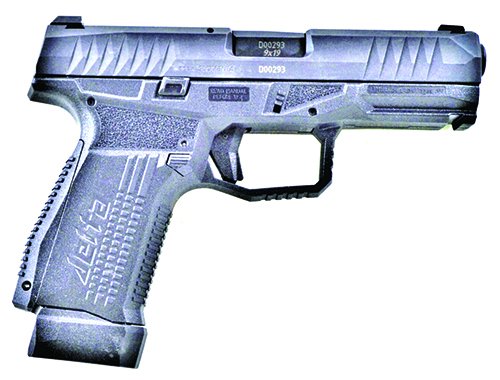
Action Type |
Semi-auto short recoil-operated locked breech, double action only (SDA) |
Overall Length |
6.9 in. |
Overall Height |
4.8 in. |
Max. Width |
1.25 in. |
Weight Unloaded |
22.4 oz. |
Weight Loaded |
27.1 oz. |
Slide Material |
Forged steel |
Slide Retraction Effort |
19.0 lbs. |
Receiver Material |
Black polymer |
Front Strap Height |
2.3 in. |
Back Strap Height |
3.2 in. |
Barrel |
4.0 in. long, 1:9.8 twist rate, 6 grooves, RH Twist |
Grip Thickness Max. |
1.15 in. |
Grip Circumference |
5.6 in. |
Magazines |
(1) 15 and (1) 17 round |
Rear Sight |
Drift adjustable |
Front Sight |
Dovetail post |
Sight Radius |
5.5 in. |
Trigger Pull Weight |
6.0 lbs. |
Trigger Span |
2.5 in. |
Trigger Travel, Reset Travel |
0.27 in./0.07 in. |
Safety |
No manual safety |
Warranty |
Limited lifetime |
Made In |
Slovenia |
Telephone |
(702) 215-3600 |
Website |
FIMEGroup.com |
This was a recent price at ClassicFirearms.com. When you look at the extra $85 for the Arex Delta over the Stoeger, you have to look at the advantage, if any, the extra dollars contribute to the pistol. Before we begin the technical description, we note one advantage between the Arex and Stoeger is in size. The Arex Delta is smaller, lighter, and thinner than the Stoeger 9mm. The Arex is slightly longer than a Glock 19, while the Stoeger pistol is slightly shorter than a Glock 17. The Arex Delta also recoils harder than the heavier Stoeger as a result of the former’s lighter weight, but then that is physics. If the Stoeger featured 17-round magazines like the Arex the line would be more blurred, but it doesn’t. We could load more than 14 rounds in the Stoeger only with great effort. With the extended-bumper-pad magazine in place, the Arex Delta is the same height as the Stoeger. But the Arex Delta holds 17 rounds in the larger magazine. And the Arex magazines are not difficult to manage at all. They are easily loaded, and they drop free when the magazine release is pressed. We confirmed this before even beginning firing. The 15-round magazine holds more than the actual number of cartridges we were able to stuff into the Stoeger magazines.
The Arex features dual slide-lock levers, which we consider a plus. There are a total of three grip inserts. The raters were in general agreement on these panels; the panels were beneficial, but one rater felt one was too raspy. That is easily changed. Another rater was equally certain the fit and texture was a reason he fired the Arex Delta well. There are dips in the grip frame above the main grip that offer a viable finger rest.
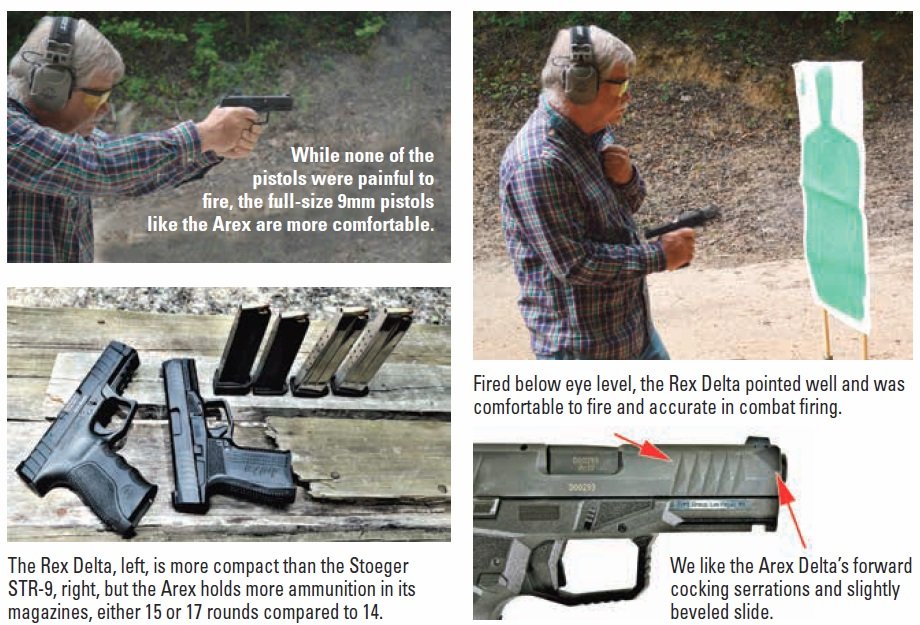
Disassembly is a bit easier than the Stoeger or the Glock as the frame pulls up and out and reassembles the same way. Ergonomics cannot be faulted. Cocking force to rack the slide, however, was the heaviest of the tested pistols.
The Arex action is similar to, but not identical to, a Glock pistol. The Arex trigger action features a definite two-stage feel that makes certain the shooter is in charge of the handgun during firing. The break is considerably lighter than the Stoeger, about 6.0 pounds even, and crisp. During the combat stage, the Arex exhibited excellent results. While the Arex Delta is a Glock 19-size pistol, it performed better than the Glock 17-size Stoeger STR-9. Because the magazine release is ambidextrous, the pistol exhibited excellent speed in reloading, left or right hand. The rear sight allows racking on the belt, although we did not practice this very much. Combat groups were good to excellent. While the pistol developed more recoil than the Stoeger STR-9, the pistol is comfortable to fire. In absolute accuracy, the pistol gave good results. Average groups were consistent at 1.9 to 3.0 inches.
The Arex pistol is clearly in the league with the Glock Generation 5, as far as accuracy potential is concerned. We took a hard look at the Rex Delta and saw that the Rex costs a bit more than the STR-9, but we feel the Delta’s superior trigger and accuracy make it the better choice.
Stoeger Industries STR-9 31721 9mm Luger, $350
GUN TESTS GRADE: B
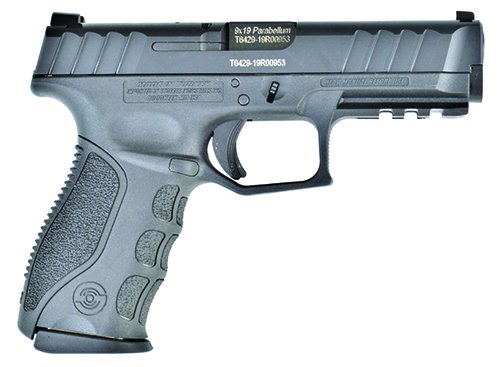
Action Type |
Semi-auto striker fired, short recoil-operated locked breech, double action only |
Overall Length |
7.2 in. |
Overall Height |
5.4 in. |
Max. Width |
1.25 in. |
Weight Unloaded |
24.0 oz. |
Weight Loaded |
27.6 oz. |
Slide |
Forged steel, black nitride finish, front and rear serrations |
Slide Retraction Effort |
22.0 lbs. |
Receiver |
Black textured polymer, accessory rail, reversible magazine release |
Finish |
Stainless steel |
Front Strap Height |
3.0 in. |
Back Strap Height |
3.5 in. |
Barrel |
4.17 in., loaded chamber indicator |
Grip Thickness Max. |
1.25 in. |
Grip Circumference |
5.9 in., 3 backstraps |
Magazines |
(3) 15 round |
Rear Sight |
Drift adjustable, two dots |
Front Sight |
Dovetail post, one dot |
Sight Radius |
5.9 in. |
Trigger Pull Weight |
7.5 lbs. |
Trigger Span |
2.75 in. |
Safety |
Trigger lever |
Warranty |
5 years |
Made In |
Turkey |
Telephone |
(301) 283-6300 |
Website |
StoegerIndustries.com |
This was a recent price at ImpactGuns.com. We found this handgun for retail in a local shop for $340. Interestingly, Stoeger is marketing the pistol in three versions. The first (31720), found for $277 in stock at ImpactGuns.com, comes with only a medium grip insert and a single magazine. We firmly believe you need at least three magazines with a service pistol — the magazine in the gun, the one on the belt, and one resting. The pistol tested (31721) comes with three grip inserts and three magazines. We feel the extra $72.50 is a worthwhile investment. Another version with night sights (31722) retails for $400 at ImpactGuns.com.
As for similarities to the Glock — one rater stated it is a Glock! — mechanically, the internal parts are identical in appearance to the Glock 17 pistol, for the most part. They do not interchange, as far as we can tell. We tried to swap some of the parts and it was a no go. Some of the pins may interchange, but that is the extent of it. The striker of the Glock is a rectangle, while the Stoeger uses a rounded firing pin. The spent brass looks just like any other handgun’s spent brass. The Glock extractor is driven by a rod plunger and spring. The STR-9 uses a longer pivoting extractor powered by a coil spring.
The STR-9 pistol is a polymer-framed design with a striker-fired action. The action is partially prepped by the slide, either by racking the slide or by the slide moving in recoil after firing. The striker is prepped against spring pressure and a press of the trigger continues to move the striker to the rear and fire the pistol. Simple enough. The Stoeger works in exactly the same manner as the Glock 17 and every other Glock handgun, and similar designs such as the Smith & Wesson Military & Police pistols. There is a lever set in the trigger that must be pressed to release the trigger. This lever also prevents lateral discharge. The action is consistent from shot to shot. The trigger action has a stiff take-up and breaks at 7.5 pounds on the Lyman digital trigger pull gauge. This trigger press is heavier than the standard Glock 5.5- to 6.0-pound press. This trigger, we felt, is a limiting factor in getting the most performance out of the STR-9. Fitting the hand to the tool felt good, and the three backstraps allow that to be fine-tuned. Finger placement and fit and feel are good. The frame features nine flats in the front strap, three on each side and three across the actual front strap, and a slight finger swell that all the raters liked.
The rear strap is nicely checkered. Some felt the rear checkering was too sharp. (Why don’t makers offer one smooth grip insert for the few that prefer this? Another 50 cents?) Slight finger indentions are located on each side of the frame, and there is a protected magazine release. The magazine release is advertised as reversible, but we did not attempt to change it. There is a light rail molded into the frame. The serial number is in the dust cover forward of the trigger guard. The trigger guard differs little from the Glock, with a squared section in the front and an undercut in the rear. Someone paid close attention to ergonomics and got it right with this handgun. The grip has something of the early model Glock and the Heckler & Koch VP9 as well.
The steel slide isn’t as square as the Glock and is nicely beveled at the top. There are aggressive cocking serrations both forward and rear. The cocking serrations were rated excellent by all raters. They are a good feature on a $340 pistol. The sights are traditional black steel sights with white three-dot inserts. They seem more similar to the SIG P320 than other types, but the height would be wrong with SIG P320 sights. The rear sight is flat on the front, allowing racking the slide with the rear sight if needed. The sights proved well regulated for factory loads. The 6 o’clock hold was used for 115-grain ammunition, 124-grain ammunition was close, and we used a dead-on hold at 25 yards for 147-grain ammunition.
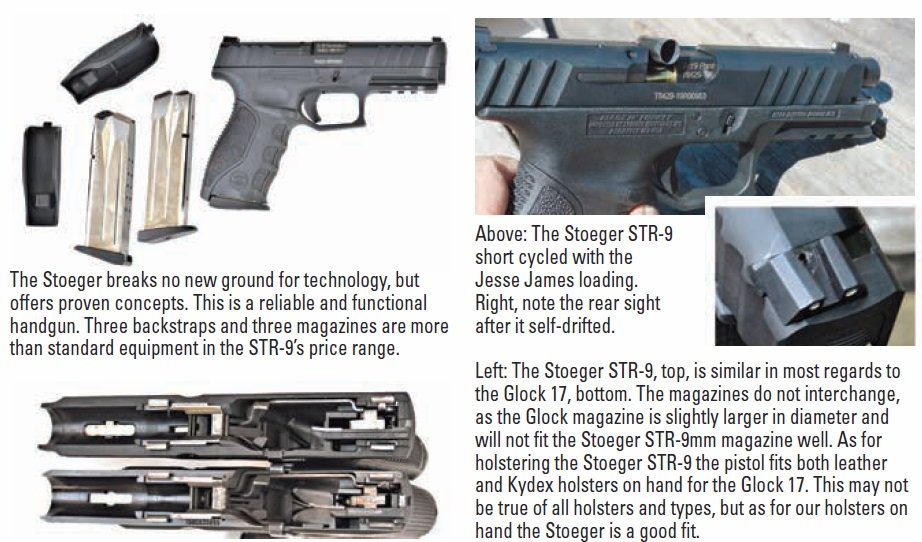
When preparing for the initial range work, the Stoeger pistol’s 15-round magazines were very difficult to load, even using the supplied magazine loader. We were able to load 10 to 11 by hand but had to use the loader (it is identical to the Glock’s) to get past this, and even so for most of the raters, the final round was a struggle. We ended up loading 14 rounds for most of the testing. We intended to use the Jesse James 124-grain JHP for accuracy testing, and of course we like to test new loads. The load short-cycled in the Stoeger STR-9. The rate of short cycle was about 40%. This was most true toward the end of the magazine when magazine spring pressure is less. This wasn’t a good start for the STR-9.
But then we chronographed the load. Average velocity was 998 fps, 50 to 100 fps below standard for the 124-grain 9mm. This load functioned in a Glock 19 on hand for reference, but only to the 13th round, the last rounds short cycled. The Ruger Security-9 functioned the load, but the slide did not lock open on the last shot. We did not try this load in the SIG or the Rex Delta. We went to the Black Hills Ammunition 115-grain FMJ and the STR-9 functioned. The magazines became a bit easier to load toward the end of the test, but the magazine loader is definitely needed to top off the final six to seven cartridges. Even at the end of the test, the magazines were what you would term stiff. Many female shooters and older shooters will find this a disadvantage. One of our aged 60+ raters was quite defeated by these magazines after 10 rounds. We have not tested anything stiffer that we can recall.
In combat firing the pistol is controllable. While heavier than we like, the trigger is smooth and consistent. The sights are good. We achieved good results in combat drills. The magazines are not drop free, in common with early-model Glock 17 9mm magazines. This is as big an issue as the user makes of it. The magazines were very uniform in the drop, and the magazine extending from the magazine well was easy enough to grasp and remove. Speed loads were not as fast as with the Arex Delta, and true speed loads were not possible. Feed reliability with the FMJ and JHP loads was excellent. Cycle reliability was not an issue once we stopped using underpowered ammunition.
The trigger, while heavy, has a rapid reset. The pistol’s grip is comfortable and recoil isn’t a factor. There were no failures to feed, chamber, fire, or eject. We rated the pistol high in combat ability. The trigger is a drawback, but only because of its weight, not its action or smoothness.
Firing for accuracy from a solid benchrest, the Stoeger gave good, but not outstanding, results. The average accuracy is on par with other polymer-frame striker-fired handguns of the same size and weight class. We felt that the Glock Generation 5, with its tighter trigger and Marksman barrel, is generally more accurate, but then it is more expensive as well. The pistol produced five-shot groups of 2.5 to 3.5 inches, very consistent and well centered. The Stoeger STR-9 is more than accurate enough for personal defense. It isn’t as accurate as the Alpha Rex 9mm, but it is close, and the Stoeger is more accurate than the two compact pistols from Ruger and SIG.
The Stoeger’s performance was rated excellent for the price, but there were demerits. After the test, we compared notes. The Stoeger STR-9 9mm pistol is a credible 9mm service-size pistol. We like the three magazines and three inserts in the version tested. We rated the pistol down a half grade based on the heavy trigger. We rated it down another half grade based on the non-drop-free magazines. Another problem that arose was that the rear sight became loose during the combat firing strings. It drifted far to one side in the dovetail. We had to re-zero the pistol. We did not rate the pistol down on this, as after we tightened the Allen screw down it did not come loose again. While not perfect the pistol is reliable with full-power ammunition, accurate enough for defense, features good grip design, and is supplied with three magazines as tested. We would buy this pistol and use it with confidence.
Ruger Security-9 Compact Model 3818 9mm Luger, $309
GUN TESTS GRADE: B
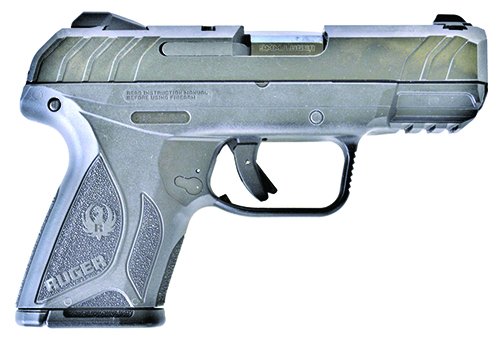
Action Type |
Short recoil-operated locked breech, modified single action |
Overall Length |
6.52 in. |
Overall Height |
4.35 in. |
Maximum Width |
1.2 in. |
Weight Unloaded |
22 oz. |
Weight Loaded |
25.6 oz. |
Slide |
Forged, hardened alloy steel, blued; front grip serrations |
Slide Retraction Effort |
19.0 lbs. |
Receiver Material |
Glass-reinforced nylon over aluminum chassis |
Finish |
Black |
Front Strap Height |
1.8 in. |
Back Strap Height |
2.8 in. |
Barrel |
3.42 in. long; blued alloy steel; 6 grooves, 1:10 RH twist |
Grip Thickness Maximum |
1.2 in. |
Grip Circumference |
5.65 in. |
Magazines |
(2) 10-round alloy steel detachable boxes |
Rear Sight |
Drift adjustable |
Front Sight |
Dovetail post, fixed |
Sight Radius |
4.9 in. |
Trigger Pull Weight |
6.5 lbs. (Secure Action) |
Trigger Span |
2.62 in. |
Safeties |
Trigger, external manual |
Made In |
USA |
Warranty |
No written warranty |
Telephone |
(336) 949-5200 |
Website |
Ruger.com |
Available in CA |
No |
Available in MA |
No |
The price is a local average from stores near our test facility in South Carolina. The original Ruger Security-9 pistol was introduced as an inexpensive handgun for homeowners and concealed-carry-permit holders. We anticipated a compact version, and the new Security-9 has came off well.
This 9mm handgun isn’t the typical polymer-frame striker-fired handgun. The Security-9 is a hammer-fired handgun. The system is similar to the Ruger LCP II. The action is fairly short, and while Ruger refers to its operation as a “Secure Action,” like many other modern handgun actions it defies a pat description. We think that it is a single action in the way it behaves, but we also agree with Ruger that is it different. The trigger is fairly short. The action isn’t difficult to control. The trigger broke consistently at a smooth 6.2 pounds. The pistol features a lever set in the trigger that prevents lateral discharge; the lever must be pressed into the trigger face to press the trigger to the rear. The pistol also features a manual positive safety. The safety is well located on the frame and falls under the thumb easily. It isn’t difficult to key off quickly, but it requires more effort to place in the Fire position. This safety isn’t going to be pressed on from recoil as you fire. This is better than a safety that moves easily to Safe, and may be the design intent. The pistol is close to the size of a Glock 19 and is supplied with two 10-round magazines. The magazines are robust, well made, and proved easy enough to load to full capacity. The pistol is supplied with a magazine floorplate extension and works fine with 15-round full-size-Security-9 magazines.
The barrel is 3.4 inches long. This barrel length develops less velocity than the 4-inch barrel of the full size pistol, but more than a 3-inch-barrel 9mm. Velocity is reasonably close to the 4-inch barrel.
The pistol is just over an inch wide and weighs just under 24 ounces unloaded. This weight is ideal for concealed carry and makes for good recoil control. The slide is blued steel, and the frame is glass-reinforced nylon. The frame is nicely textured for control. The slide-cocking serrations are well designed and are not difficult to work with.
The pistol has a good appearance, even rakish and ultra modern. The sights are well designed for rapid acquisition and worked well in firing for accuracy as well. The rear is a bar and the front is a white dot. The rear sight is adjustable for windage. Pebbling on the front strap, rear strap, and sides of the grip are excellent. The pistol features a short light rail. The balance, feel, and fit in the hand are good.
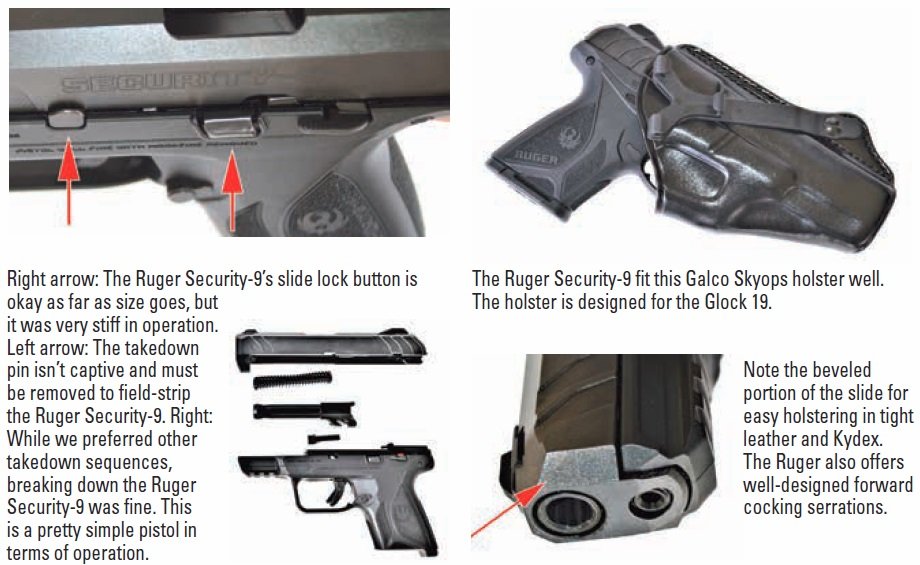
At the firing range, we found the magazines were not difficult to load to full 10-round capacity. The magazine seated positively. When firing the pistol, the shooter establishes a certain rhythm, largely dependent on trigger and recoil control. Press the trigger, allow the trigger to reset in recoil, and fire again as soon as the sights are acquired. The pistol is more than accurate enough for personal defense. It is a soft shooter and controllable.
As for bench accuracy, the pistol is capable of making head shots at 15 yards. The pistol isn’t as accurate as the larger guns, but it is accurate enough for concealed carry.
A demerit appeared as we tried to make rapid speed loads. The slide lock is very difficult to release. Some of the raters could not release it with one hand. While the slide release loosened a bit with use, this isn’t ideal for personal-defense use.
Most of the raters did not like the Security-9’s takedown sequence. Tipping the takedown lever out requires some type of tool. We prefer a pistol that features captive parts, not one that requires a rod be taken out and laid aside. We rated the pistol down a half grade based on the stiff slide lock and another half grade on the takedown. For the money, we would buy it ahead of the SIG P365.
SIG P365 Nitron Micro-Compact 365-9-BXR3 9mm Luger, $465
GUN TESTS GRADE: B
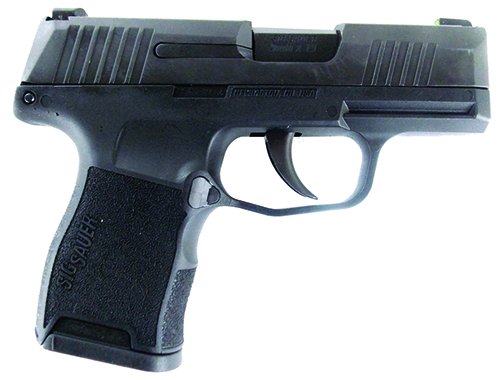
Action Type |
Semi-auto striker fired, short recoil-operated locked breech, double action only |
Overall Length |
5.8 in. |
Overall Height |
4.4 in. |
Maximum Width |
1.0 in. |
Weight Unloaded |
17.8 oz. |
Weight Loaded |
20.9 oz. |
Slide |
Stainless steel, black Nitron finish |
Slide Retraction Effort |
17.5 lbs. |
Receiver Material |
Black polymer |
Front Strap Height |
1.8 in. |
Back Strap Height |
2.5 in. |
Barrel |
3.1 in. long, carbon steel |
Grip Thickness Maximum |
0.9 in. |
Grip Circumference |
4.9 in. |
Magazines |
(2) 10-round stainless |
Rear Sight |
Drift adjustable, X-RAY3 Day/Night |
Front Sight |
Dovetail post |
Sight Radius |
5.0 in. |
Trigger Pull Weight |
6.0 lbs. |
Trigger Span |
2.5 in. |
Safety |
No manual safety |
Made In |
USA |
Warranty |
Limited lifetime |
Telephone |
(603) 610-3000 |
Website |
SIGSauer.com |
The P365 is the priciest pistol tested. Yet we routinely see these pistols at shops marked up over $500, and used pistols with an asking price well over $400. The pistol is popular and seems to hold its value. Our job is to determine what that value may be in a practical sense. The pistol features the standard for modern times, a prepped or partly cocked striker, when the pistol is at ready. The striker is loaded or prepped by racking the slide. The trigger is pressed to move the striker to the rear, breaking the striker against spring pressure. The striker runs forward and the pistol fires. We found the trigger action smooth enough. There is no spongy reset; this pistol features a sharp reset. The trigger action broke cleanly at 6.3 pounds originally, settling into 6.0 pounds by the end of the test period.
The slide is Nitron coated and should be resistant to corrosion. The slide features a good set of combat sights that we found worked well in both rapid fire and in firing for maximum accuracy. The pistol also features forward cocking serrations. The frame is comfortable for most hand sizes and properly pebbled. The grip frame is designed, according to SIG, around the 10-round magazine. The magazine is surprisingly slim for a 10-round magazine, but if you look at the whole picture, it is understandable. Most of the slimline 9mm magazines are not exactly vertically aligned, but rather staggered, which allows the designers to fit 7 rounds into a 6-round platform. SIG was able to fit the 10-round magazine into the P365 with a modest 0.45-inch magazine extension. The resulting design is 0.1 inch thinner than most any double-column magazine.
The result is a remarkably slim grip frame for the capacity. We understand why engineers were tasked to design the magazine first. The category of handguns that is most popular in America for concealed carry is the slimline 9mm. The single stacks will be threatened by the 10-round-magazine SIG P365, we believe.
The pistol features but three controls, the takedown lever, slide lock, and magazine release. The pistol is as small as possible. This is good for concealed carry but not ideal for handling. The pistol demands a different set of skills than handling a full-size pistol. Considerable adjustment, as an example, is demanded when moving from the Rex Delta to the SIG P365. The thumbs-forward grip many of us use isn’t possible with the slim P365. The controls are tight, and one of the raters let his thumb drift into the slide during his firing strings. This was not counted against the pistol, this is shooter error. Another rater allowed his thumb to press against the slide of the SIG P365 during firing and slowed the slide down enough to cause a short cycle. No fault of the gun, but a serious consideration for anyone adopting the P365 for personal defense. That said, the pistol gave good results on the firing range. During combat firing, the pistol was the equal of the Ruger, perhaps slightly superior overall. We felt the trigger action of the SIG was superior to the Ruger 9mm handgun. Recoil, however, was considerably stiffer than the Ruger’s, we thought.
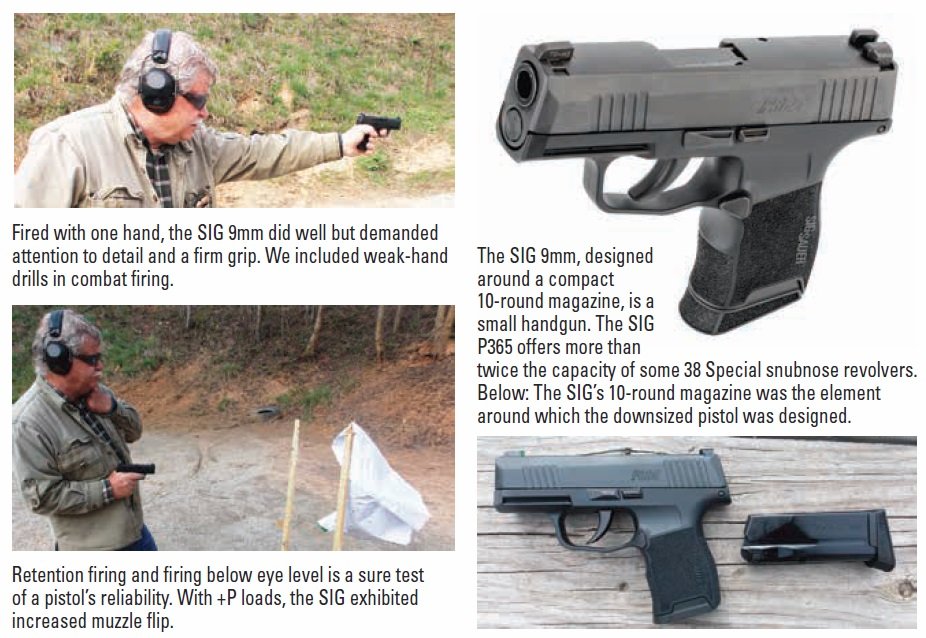
When we fired the P365 from a solid benchrest, the SIG turned in smaller groups than the Ruger, but not by a huge margin. The SIG features good sights and also features a good trigger action. A drawback is that while the P365 features a light rail, it will only accept certain SIG lights.
When firing the pistol, we used it in several drills, including retention drills and weak-hand drills. This is a test of function that will expose a propensity toward short cycles. The pistol functioned fine and never stuttered during this test. Recoil with the +P load, however, as one rater stated, was startling. When firing the Winchester PDX +P load in the Stoeger and Arex pistols, there was little discernible difference in recoil. The 9mm simply isn’t a hard kicker. In the Ruger, we noticed the difference, and in the SIG, recoil was stout.
This is another consideration when choosing a personal-defense handgun, and the tolerance for recoil will differ from person to person.
The SIG P365 gave a credible showing in the personal defense drills, clearly equal to the Ruger. In firing for maximum accuracy, neither the Ruger Security-9 Compact or the SIG P365 was a tackdriver, but each was accurate enough for personal defense. The SIG had the edge in absolute accuracy. We feel that this edge was primarily a result of the SIG’s superior trigger action. We rated the pistol down a half grade on cramped hand fit for some raters, which is part of the game for such a compact pistol, and another on the expense. Just the same, this is a credible handgun that should serve many shooters well.
Our Team Said
- We would buy the Ruger Security-9 Compact and use it with confidence. We would also purchase the SIG P365 Micro-Compact. The Ruger is the better buy, in our opinion, but we recognize the SIG offers good performance, and we especially liked the SIG trigger.
- In the case of the service-size pistols, the race was not as close. The Stoeger STR-9 is comparable to a Glock 17 in many ways and performed with reliability using full-power loads. But there were nagging concerns with the STR-9 that Glock fixed a long time ago. The STR-9’s magazines do not drop free, so you will not run a combat course in record time with this gun. The rear sight coming loose isn’t worth nagging about, and while it could have happened to any handgun, it hasn’t happened to many we’ve tested. The magazines were very difficult to load, going past an inconvenience to a genuine deal breaker. They were simply too stiff and never lightened enough for the raters to comfortably load the magazines to full capacity. In most ways, the STR-9 is a reliable half-price Glock, but we wouldn’t buy it.
- The Rex Delta is smaller than the Stoeger in most dimensions, equally reliable, and exhibited no problems with the trigger, magazine, slide lock, or accuracy. The bottom line is the Rex Delta is well worth a few more dollars than the STR-9.
- When we began these tests, we were looking for economical handguns that will serve well for personal defense. One of the raters pointed out that most of us need a larger gun and a smaller gun — one for home defense and carry under a jacket, the other for concealed carry under a polo shirt. The Rex Delta is a compromise that would do well in either role.
Written and photographed by Gun Tests Staff, using evaluations from Gun Tests team testers.


























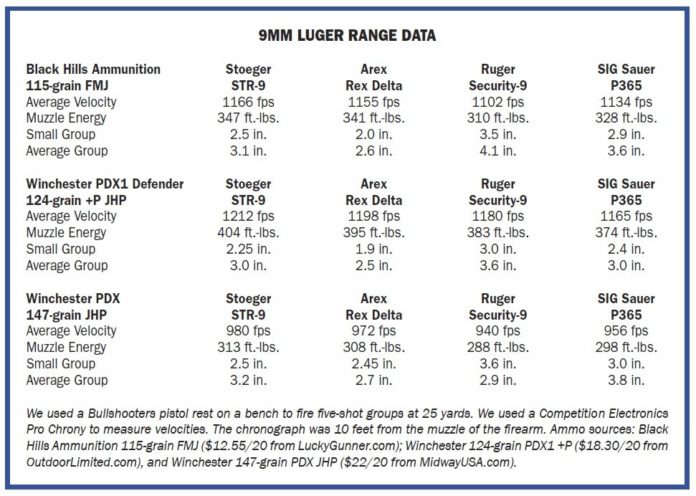


I have previously subscribed to Gun Tests and opted out because of terrible ratings. But, I thought I would give you another chance. Nothing has changed, the same BS. The Sig P365 is a very well built pistol, didn’t have any hiccups but came in with a B rating, (because of the price) ???????????????? Some of the other crap you hold in high esteem gets an “A” rating???????????? Please get someone that can give a fair appraisal or I’m canceling my subscription. I have discussed your tests with other folks and they all tell the same story, “the raters don’t have any knowledge about firearms”. Hey, we all need to stick together in these trying times but lets do some improving in this department.
I’m not going to be as harsh as Garry but I have certainly noticed that Gun Tests has a certain amount of myopia where it comes to firearm brands.
The title is “Four New 9mm Pistols” but no RIA STK100?? No SCCY DVG1?
Doing a quick search of your online archives, Gun Tests hasn’t reviewed a SCCY since 2012 and you’ve *never* reviewed an RIA MAPP.
What gives? Did Martin Tuason call you a poopyhead? Did Joe Roebuck give you a wedgie?
I tend to agree with the subjectiveness of some of the ratings versus objectiveness that I look for.